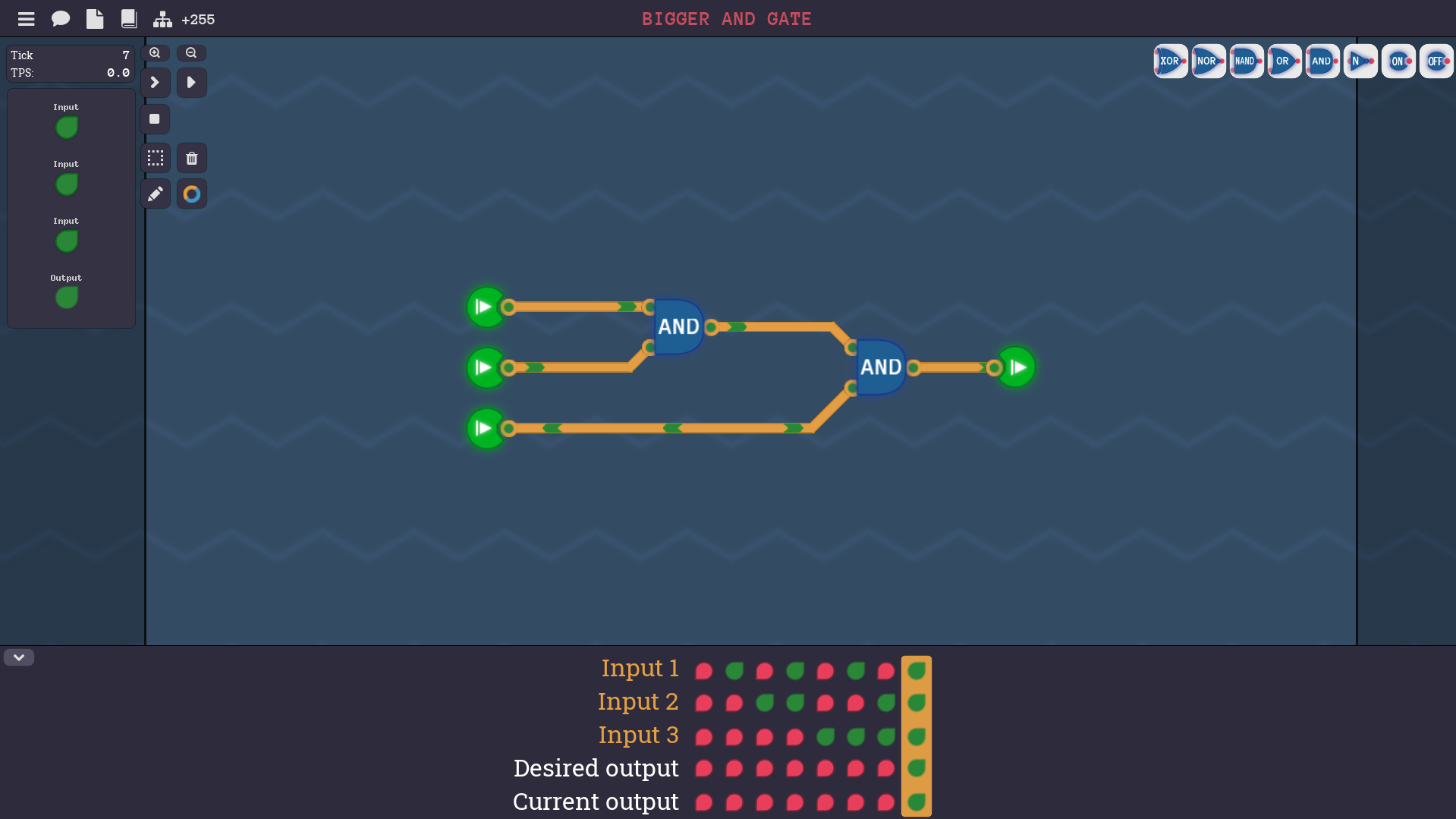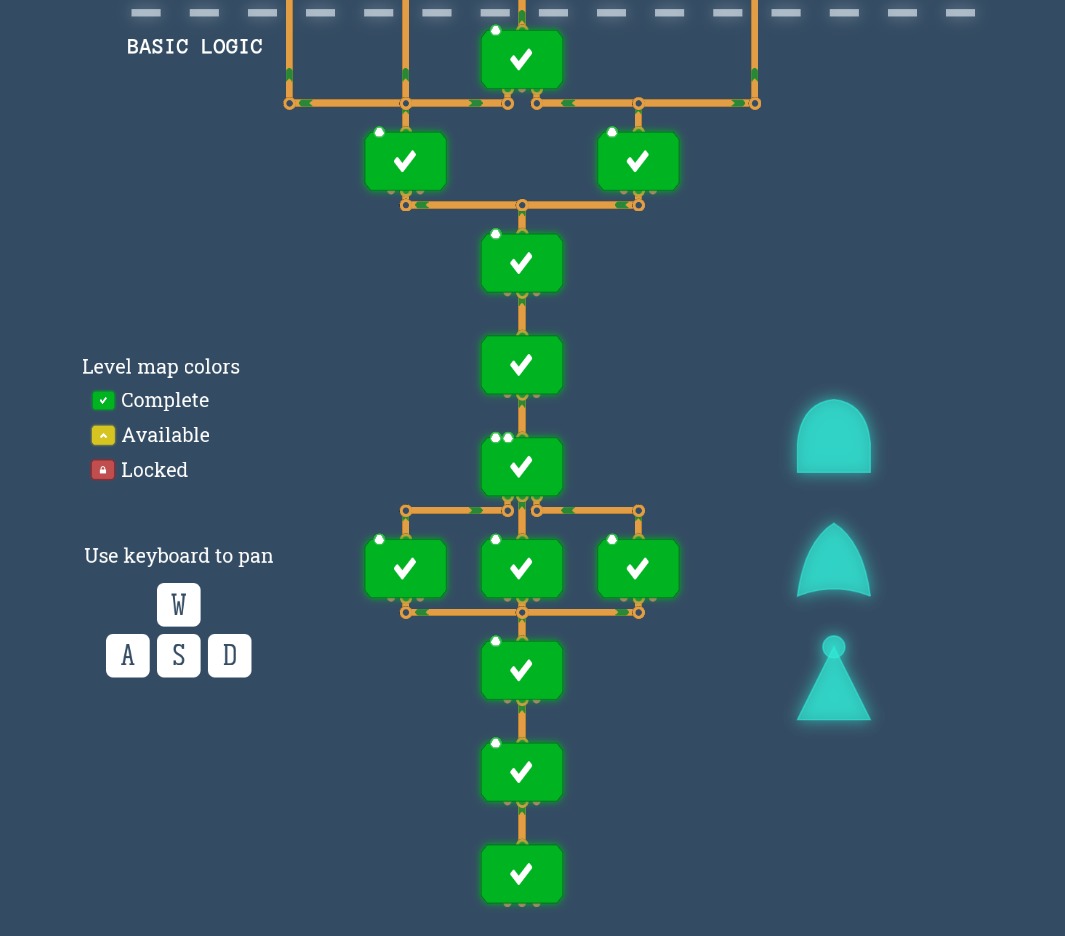
Thomas Tran
Welcome to my website!
Basic Logic
Quick Navigation
Section Overview
In this section, we will go through all the Basic Logic levels. These include digital logic gates such as NOR, NOT, NAND, and others. Note that we are skipping the first level since it is simply connecting two nodes with a wire(Which, if you need an explanation, is how we get a signal to flow from the input to the output).
Quick Navigation
Challenges
NAND Gate
What is a NAND gate? Think of a NAND gate like a doorman at a club with two switches. Both switches must be turned ON (we call them 1 and 2) for the doorman to say NO (our output, which would be 0). In any other situation - if either switch or both switches are OFF - the doorman says YES (which would output 1). It’s one of the most basic building blocks in computers which you can use these simple yes/no decisions to create all the complex operations that happen in modern electronics.

NAND gates are the introverts of logic—they prefer NOT to AND together.
NOT Gate
A NOT gate is like a light switch that does the opposite of what you tell it - when you say ON (1), it gives you OFF (0), and when you say OFF (0), it gives you ON (1). It’s like opposite day, except a circuit!

AND Gate
Now let’s say this - we only have NOT and NAND gates at our disposal and we want to create a gate where when both inputs are 1, then our output is ON. Think of an AND gate as a clever combination of gates: we take a NAND gate and then add a NOT gate after it. This flips the NAND’s output to give us what we want - now we only get YES (1) when both inputs are ON (1), and NO (0) for everything else.

A clever way of creating an AND gate with just a NOT and a NAND gate!
NOR Gate
Let us say we want the opposite of OR’s outputs, in this case, a NOR gate. How do we make this with just NAND and NOT gates? We can first NOT both inputs of NAND to flip our outputs, and then NOT the output of NAND to get the opposite of our outputs!

OR Gate
Of course, we cannot forget about the OR gate. To make this with just NOT and NAND gates we can simply NOT both inputs just like before. That way we are able to get the outputs!

ALWAYS On
For this, we simply just want to create a circuit that is always on. We also get NOR, NAND, OR, AND, and NOT gates at our disposal. So how do we make an always-on circuit? Think about how a NAND gate works if we just have two ticks(brief signals). One tick will output low (0), the next tick will output high (1). We want the desired output of both ticks to be high. If we recall from implementing our NOT gate, we know that both inputs into NAND will create a behavior where the low input will produce a high output, while a high input will create a low output. This time we will simply just NOT one of the wires to create a situation where because both inputs are high and low, since they are neither high or low, they will always be producing a high output!

Second Tick
Again, recall that ticks are brief signals. We want to output high on the second tick only. How do we do that? We can implement this by using NOR gate logic! Remember, when neither inputs are high, the output will be high. So we can use a NOT gate as input 1 and an AND gate as input 2. A NOT gate will ensure that on second tick, in which input 1 is high, we will get it to be low to pass for one part of NOR. For the AND gate, at the second tick, we have the input set as low. That means our AND gate will be able to also produce a low signal. As for the next ticks, the AND gate can cover us by staying high since the last inputs for input 2 are high!

XOR Gate
First, observe the XOR truth table. We can see that the output is high when either input 1 or input 2 is high, but not when it is both. This is almost similar to an OR gate except the XOR gate does not like it when both inputs are high. So what do we do? Well we do know that the OR gate is almost giving us what we want, it’s just that the last output is wrong. We can also recall the truth table for NAND gate. That also gives us almost what we want, but its first output is wrong. The solution? Let’s just use them both and combine their outputs with an AND gate! This works since the AND gate outputs high when both NAND and OR agree!

Bigger OR Gate
For this, we are simply creating an OR gate with three inputs. We can create this by combining inputs 1 & 2, while the second OR gate combines the result with input 3. So if any input is high, the final output will be high.

Bigger AND Gate
Similar to before, we combine inputs 1 & 2 with an AND gate. We then have a second AND gate to combine the result with input 3. Now the output is high only when ALL inputs are high.

XNOR Gate
We can just take the XOR gate and NOT its output to produce an XNOR gate table!


